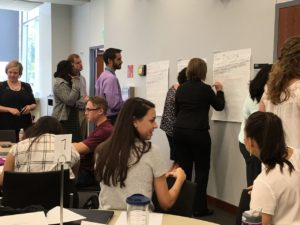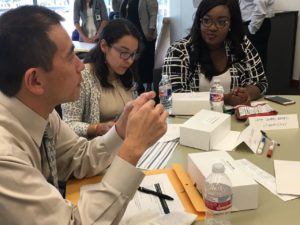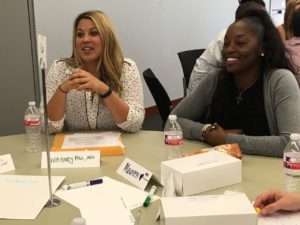New students consider public health myths, perceptions
September 28, 2016 • Uncategorized
“In any field, it’s important to know how to work together with people who are different and come from backgrounds other than our own. Especially in community health, we find solutions in unique ways through collaboration with others. Each perspective brings something important to the table,” said Karen Bell, PhD, Assistant Professor and Director of the UNTHSC Department of Behavioral and Community Health.
Dr. Bell recently co-presented an Interprofessional Education (IPE) event for incoming College of Public Health graduate students with Assistant Professor Marcy Paul, PhD, to address beliefs, questions and myths about different public health concentrations and the overall field.
Prior to attending, the 47 new students were asked to complete a survey of their own backgrounds, academic concentrations, how they would rank statements about common public health assumptions, and to write words and phrases that they felt best described different types of public health practitioners.
“Warm, inviting, jovial, loving, prevention-oriented, focused on a healthy society, approachable, good listeners, casual dressers, fun and big picture people” were all how students thought of Behavioral and Community Health professionals, while “serious, strict, technical, intelligent, math wizards, nerds, critical thinkers, research focused and people with tedious jobs” were some assessments of biostatisticians.
Epidemiologists were viewed as “science-oriented,” people who work “overtime,” and those involved in “the disease process, data analysis/collection, surveillance investigations and working closely with physicians.” Some students noted “exotic international locations” when describing an epidemiologist, and also saw them as “inquisitive, pioneers in public health and first responders.”
Students described Environmental and Occupational Health Sciences professionals as being “hippies, outdoorsy, tree huggers and one with nature,” focusing on environmental issues like air quality, pollution, infectious disease, healthy drinking water, “messy” landfills, workforce hazards and occupational health. They were seen as “not so great at math” and “protectors of humans, animals and trees.”
Health Management and Policy professionals, on the other hand, were labeled as “well dressed, leaders, change agents, business and policy oriented,” sometimes as “bossy” and as people who “love health records.” One comment described them as having the “largest form of control over public health.”
CPH faculty also weighed in on the conversations, including Assistant Professor Doug Livingston, PhD, a Biostatistics and Epidemiology researcher.
“Epidemiology is hard to pin down. What people do really varies. Some are out in the field. As for me, I stay out of jungles. Much of my work is in front of a computer,” he said.
Importantly, the event pushed students to think beyond their initial perceptions and look at public health in a broader way.
“When you graduate, you’ll be working with many people across professions and within communities – even the word community can have different applications, whether it’s a neighborhood, city, county or state, even a country,” said Dr. Paul.
“So think on a larger scale than your own ‘world,’ because people representing varied backgrounds, experiences, even cultures, are all part of the larger public health community that it takes to recognize assets and challenges, solve a problem or create change.”





Social media